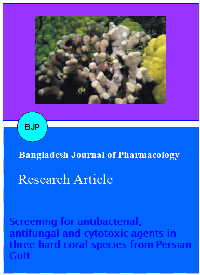Screening for antibacterial, antifungal and cytotoxic agents in three hard coral species from Persian Gulf
DOI:
https://doi.org/10.3329/bjp.v9i2.17825Keywords:
antibacterial, antifungal, cytotoxicAbstract
Within the frame of a biodiversity and bioactivity study of marine macro organisms from the Persian Gulf, three hard coral species extracts were investigated for cytotoxic, antibacterial and antifungal activities against five human pathogenic microorganisms. All concentrations of extracts from three hard corals showed no antifungal activity towards the tested strains. In antibacterial assays the hard coral extracts showed significant activity solely against Staphylococcus aureus with MICs ranging from 3 to 9 mcg/mL. The highest antibacterial activity was found in the aqueous methanol extract of Porites compressa with an inhibition zone of 22 mm against Staphylococcus aureus at 18 ?g/mL extract concentration. It is important for future research to concentrate on finding the mechanisms employed by corals to defend themselves against invasion, the mechanism of infections and the type of chemical compounds in coral extracts that inhibit antibacterial growth or proliferation in underexplored areas such as the Persian Gulf.
Downloads
433
366 Read
16
References
Bak RPM, Lanne RWPM. Annual black bands in skeletons of reef corals (Scleractinia). Mar Ecol Prog Ser. 1987; 38: 169- 75.
Bhosale SH, Jagtap TG, Naik CG. Antifungal activity of some marine organisms from India against food spaelage Aspergillus strains. Mycopathologia 1999; 147: 133-38.
Bruno JF, Selig ER. Regional decline of coral cover in the Indo-Pacific: Timing, extent, and subregional comparisons. PLoS ONE. 2007; 2: e711.
Flora CJ, Ely PS. Surface growth rings of Porites lutea Microatolls accurately track their annual growth. Northwest Sci. 2003; 77: 237-45.
Fostel J, Lartey P. Emerging novel antifungal agents. Drug Disc Today. 2000; 5: 25-32.
Geffen Y, Rosenberg E. Stress-induced rapid release of antibacterials by scleractinian corals. Mar Biol. 2005; 146: 931–35.
Giordani R, Trebaux J, Masi M, Regli P. Enhanced antifungal activity of ketoconazole by Euphorbia characias latex against Candida albicans. J Ethnopharmacol. 2001; 78: 1-5.
Glynn PW. Bioerosion and coral reef growth: A dynamic balance. In: Life and death of coral reefs. Irkeland C. (ed.). New York, Chapman & Hall, 1997, pp 68-95.
Hadacek F, Greger H. Testing of antifungal natural products: methodologies, comparability of results and assay choice. Phytochem Anal. 2000; 11: 137-47.
Hellio C, Bremer G, Pons AM, Le Gal Y, Bourgougnon N. Inhibition of the development of microorganisms (bacteria and fungi) by extracts of marine algae from Brittany, France. Appl Microbiol Biotechnol. 2000; 54: 543-49.
Kendrick B, Risk MJ, Michaelides J, Bergman K. Amphibious microborers: Bioeroding fungi isolated from live corals. Bull Mar Sci. 1982; 32: 862-67.
Kim K. Antimicrobial activity in gorgonian corals (Coelentrate, Octocorallia). Coral Reefs, 1994; 13: 75-80.
Koh EGL. Do scleractinian corals engage in chemical warfare against microbes? J Chem Ecol. 1997; 23: 379-98.
Kreitlow S, Mundt S, Lindequist U. Cyanobacteria: A potential source of new biologically active substances. J Biotechnol. 1999; 70: 61-63.
Le Campion-Alsumard T, Golubic S, Priess K. Fungi in corals: Symbiosis or disease? Interactions between polyps and fungi causes pearl-like skeleton biomineralization. Mar Ecol Prog Ser. 1995; 117: 137-47.
Miroslav G, Longin T, Stanić KD, Miller AW, Richardson LL. Antibacterial activity of marine and black band disease Cyanobacteria against coral-associated bacteria. Mar Drugs, 2011; 9: 2089-2105.
Mohammadizadeh F, Ehsanpour M, Afkhami M, Khazaali A, Mokhlesi A, Montazeri S, Bahri A. Antibacterial, antifungal and cytotoxic effects of a sea cucumber Holothuria Leucospilata, from North coastal of the Persian Gulf. Marine Biol Assoc J. 2013; 1-5.
Mohammadizadeh F, Ehsanpour M, Afkhami M, Mokhlesi A, Montazeri S. Evaluation of antibacterial, antifungal and cytotoxic effects of Holothuria scabra from North Coast of the Persian Gulf. J De Mycologie Médicale. 2013.
Nissimov JRE, Munn CB. Antimicrobial properties of resident coral mucus bacteria of Oculina patagonica. FEMS Microbial Lett. 2009; 292: 210-15.
Pivkin MV. Filamentous fungi associated with holothurians from the Sea of Japan, off the Primorye Coast of Russia. Biol Bull. 2000; 198: 101-09.
Raghukumar C, Raghukumar S. Fungal invasion of massive corals. PSZNI: Mar Ecol. 1991; 12: 251–60.
Ritchie KB. Regulation of microbial populations by coral surface mucus and mucus-associated bacteria. Mar Ecol Prog Ser. 2006; 322: 1-14.
Rohwer F, Seguritan V, Azam F, Knowlton N. Diversity and distribution of coral-associated bacteria. Mar Ecol Prog Ser. 2002; 243: 1-10.
Sheppard A, Fenner D, Edwards A, Abrar M. Ochavillo D. Porites harrisoni. 2008. In: IUCN Red List of Threatened Species.
Veron JEN. Corals of the world. Vol 3. Australia, Australian Institute of Marine Science and CRR Qld. Pty. Ltd. 2000, p 490.
Wang SK, Duh CY, Wu YC, Wang Y, Cheng MC, Soong K, Fang LS. Cytotoxic cembranolides from the soft coral Lobophytum michaelae. J Nat Prod. 2009; 72: 324.
Wegley L, Edwards R, Rodriguez-Brito B, Liu H, Rohwer F. Metagenomic analysis of the microbial community associated with the coral Porites astreoides. Environ Microbiol. 2007; 9: 2707-19.
World Health Organization. The World Health report. Life in the 21st century: A vision for all. Geneva, World Health Organization, 1998, pp 39-60.

Additional Files
Published
How to Cite
Issue
Section
License
Authors who publish with this journal agree to the following terms:
- Authors retain copyright and grant the journal right of first publication with the work simultaneously licensed under a Creative Commons Attribution License that allows others to share the work with an acknowledgement of the work's authorship and initial publication in this journal.
- Authors are able to enter into separate, additional contractual arrangements for the non-exclusive distribution of the journal's published version of the work (e.g., post it to an institutional repository or publish it in a book), with an acknowledgement of its initial publication in this journal.
- Authors are permitted and encouraged to post their work online (e.g., in institutional repositories or on their website) prior to and during the submission process, as it can lead to productive exchanges, as well as earlier and greater citation of published work (See The Effect of Open Access).
